




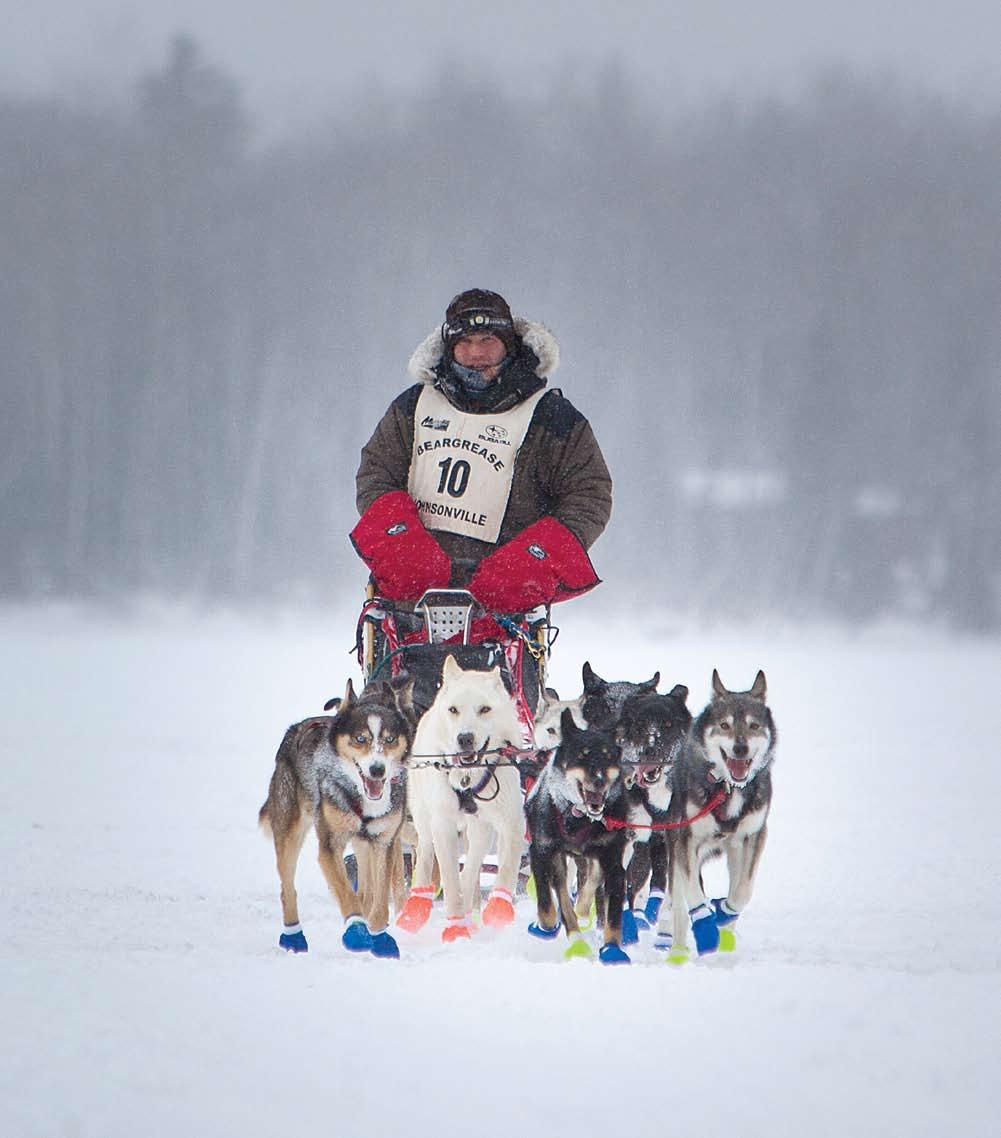









Winter has a way of sneaking up on you. Most of us finish up with autumn backyard chores and hunting seasons just in time to get swept up in the holiday rush. The next thing you know, it’s Christmas. And nearly always in this neck of the woods, it’s white.
Tourism operators often say the winter season begins with the Christmas holidays. However, that doesn’t mean winter lovers are hunkered down indoors when December snows start to fall. Although the days are short, many of us find ways to get out and enjoy them, whether for a first ski, a snowmobile ride or an early ice-fishing excursion. Not only do we get a little preview of fresh air, but those
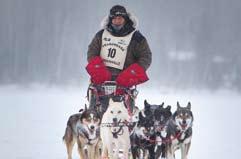
Grand Marais photographer captured this image of a dog team crossing Devil Track Lake during a previous running of the John Beargrease Sled Dog Marathon. | Stephan Hoglund
Shawn Perich, Editor • editor@northernwilds.com
Javier Serna, Managing Editor javier@northernwilds.com
available.

Contributors: Elle Andra-Warner, Paul Blissenbach, Lee Boyt, Gord Ellis, Joan Farnam, Michael Furtman, Bryan Hansel, Mike Hillman, Stephan Hoglund, Breana Roy, Kate Watson
December romps are a preview of the winter to come.
When winter arrives in all its cold and snowy glory, we’re ready for it. In the Northern Wilds, folks refuse to stay indoors. We get out there and have fun. Some folks, like writer/photographer Bryan Hansel, explore nearly endless cross-country ski trails or head off into untracked snow. Unlike, most of us, the intrepid Hansel doesn’t settle for skis, but also finds time to launch his sea kayak among Lake Superior’s ice flows.

Wildlife photographer Mike Furtman has found the cold doesn’t affect his camera gear if careful with it, so he can continue pursuing photogenic critters in a winter world. Javier Serna likes to bundle up and go ice fishing, ever hopeful they’re biting beneath the ice. Lee Boyt says you don’t need to own a snowmobile to hit the Northern Wilds’ many miles of groomed trails, because you can rent them from local businesses.
Mushing enthusiasts can participate as spectators or volunteers in three different dog races this winter: the John Beargrease Sled Dog Marathon, Ely’s WolfTrack Classic and the Gitchigami Express. While
the long-distance Beargrease has a plethora of activities round its Duluth start, the new Gitchigami Express is designed as a spectator-friendly stage race, where daily starts and evening events allow opportunities to get close to the dogs and meet the mushers. The mid-distance WolfTrack Classic will begin in Ely and finish at the new community center in Cook.
For those who prefer to ride out winter in an easy chair, we offer some fine reading. Ion Mike Hillman spins an unusual ice-fishing yarn about his frozen father. Elle Andra-Warner takes a closer look at mysterious mooring stone found at many locations across the Northern Hemisphere. And ever-green Joan Farnam offers at interesting look at how a warming climate is beginning to affect gardening. So settle in and start reading. A long and lovely winter lies ahead.
—Shawn Perich and Amber Pratt



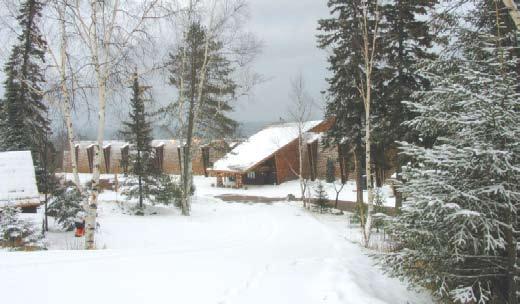




Minnesota’s Jay Cooke State Park, which was closed for four months after severe flooding damaged roads, trails and bridges in June, reopened on Oct. 22.
Visitors must use the west entrance from Thomson, and motorists should expect road construction. Highway 210 is not expected to reopen throughout the park until next year or 2014.
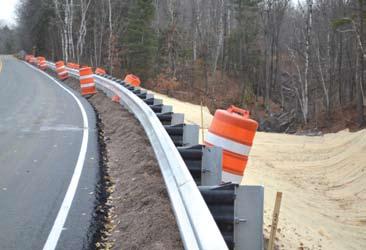
Highway 210,which was washed out by severe June floods, has been repaired, but is not fully open yet. MINNESOTA DNR
While some trails will remain closed, an estimated 38 miles of hiking trails are open and 8-10 miles of cross country ski trails will be groomed this winter.
The park’s historic swinging bridge, however, won’t re-open until late next summer after extensive repairs have been completed, according to the Minnesota DNR. That has resulted in limited access to trails on the south
side of the park, though visitors may access these trails from Highway 23 on the southeast end of the trail and from Carlton Trail on the west side.
The Willard Munger Trail, which runs through the park, was to remain closed until further notice, though initial repairs on the 14-mile section between Thomson and west Duluth were scheduled to be completed Dec. 1, potentially in time for the start of the snowmobile season. Additional repairs are scheduled for spring.
New regulations went into effect on Fish Lake in St. Louis County on Dec. 1, protecting larger, spawningaged walleye.
The Minnesota DNR enacted an expedited emergency rule to deal with declining walleye abundance in the face of increased abundance of bass, bluegill, crappie and northern pike on the lake.
The rule established a “harvest” slot, meaning only fish between 13 and 17 inches may be kept. And the bag limit has been reduced to three. Previously, the lake was under the normal statewide walleye regulations, where six fish could be kept, only one more than 20 inches. This slot differs from the typical “protected” slot on other Minnesota lakes, where fish inside the slot have to be released.
Over the past year, a stakeholder committee met and reviewed data and noticed changes in both fish
The Minnesota DNR hired Leslie McInenly as big game project leader, and she will lead the management of the state’s deer, elk and moose seasons and populations.
McInenly has worked the last six years for the Minnesota Forest Resources Council, a state board that advises the governor and Legislature on forest resource policy. Her career includes four years in Alberta, where she worked on the Central East Slopes Elk Study, which evaluated elk translocation efforts and habitat use.
McInenly holds a Bachelor of Science degree in wildlife management and biology from the University of Wisconsin-

Stevens Point and her master’s degree thesis focused on changing elk migration patterns on native prairie biodiversity and nutrient cycling.
It’s certainly not the first time the public has been warned against feeding wildlife, but the Ontario Ministry of Natural Resources put out another reminder this fall.
Feeding wildlife generally does more harm than good, the Ministry said. Wild animals become dependent on artificial food sources and lose their fear of humans and pets, becoming more prone to conflicts.
abundance and habitat, with some areas of the lake also concurrently seeing an increase in aquatic vegetation.
It’s not healthy for them, either. When animals congregate in high densities around feeders, it can spread parasites
“One of the committee’s biggest concerns was the decline in abundance of walleye, so many of their recommendations focused on the best approach to identifying causes and preventing further declines in walleye abundance,” said Deserae Hendrickson, DNR’s Duluth area fisheries supervisor. “This special regulation is designed to protect the larger spawning stock as well as younger fish entering the fishery.”
Though the emergency rule was enacted, the normal rule-setting process will still occur in 2013, which will include additional public input. The rule could potentially be made permanent for 2014.

and diseases such as Chronic Wasting Disease. Feeding animals near roads can increase their chance of being hit a vehicle. The practice also tends to attract unwanted animals, and habituated animals can become aggressive. So keep your distance, the Ministry stressed. Keep household waste, compost and pet food out of the reach of wild animals. Don’t put out food to attract wildlife. Don’t approach or touch wild animals. Don’t feed pets outside and allow them to roam free. And don’t put garbage out until the morning of collection.






Ontario recently joined the Asian Carp Regional Coordinating Committee in another step to prevent Asian carp from being introduced to the Great Lakes.
The committee was established by the U.S. government in 2009 to coordinate efforts to prevent the fish from getting into the Great Lakes.
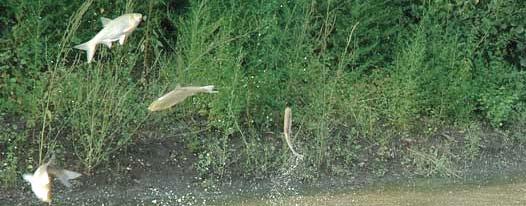
If Asian carp enter the Great Lakes, they could potentially hurt native fishes by eating their food supply and crowding them out of their habitat. Research by
Oceans Canada released this year suggested that if the planktonfeeding invasive carp were to get into the Great Lakes, Lake Superior
Minnesota hunters killed 46 bulls during October’s 16-day bull moose season, according the Minnesota DNR. This does not include tribal harvests.
This year’s lottery hunt had 76 once-in-a-lifetime licenses in 30 zones, down from 105 licenses the year before. There were 3,436 applicants in 1,669 parties of two to four hunters that applied for the tags. The bag limit is one antlered bull moose per party. Last year, there were 53 moose killed.
And while seven fewer moose may not be statistically significant, the herd has been declining at an alarming rate. Last winter’s aerial survey estimated 4,230 moose, down 14 percent from the previous year and less than half from 2006.


would be the least affected, while fertile Lake Erie would be worst hit.
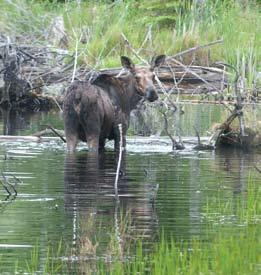


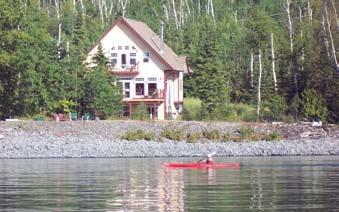
Celebrate this holiday season with shopping, skiing, snowshoeing, and much more. Each weekend starting November 23 offers new themed events for the whole family. Themes include Handmade Traditions Weekend, Artisans and Authors Weekend, Gems of the North Weekend, and A Very Merry Christmas Weekend.
This new three-day sled dog race will run from Grand Portage to the Gunflint Trail, to Grand Marais, and return to Grand Portage. The race will celebrate the history of dog mushing in Cook County. There will be a 30-team limit for this spectator-friendly event. For more info, visit www.gichigamiexpress.com.
In Ely, they celebrate winter in a big way with the Ely Winter Festival, a 10-day extravaganza chuck-full of events and festivities. Actually, the events begin prior to the festival with a snow carving contest in Whiteside Park, where giant blocks of snow are transformed into stunning sculptures. This winter, the carving contest runs from Jan. 27-Feb. 3. Another creative aspect of the festival is the Ely ArtWalk, where local businesses display paintings and other works of art by local artists. The first weekend features a voyageur encampment, where you can learn how fur traders survived winters 200 years ago. Other activities include a snowshoe walk to the Hegman Lake pictographs, dog sled tours, a snowmobile radar run, tours of the Dorothy Molter Museum, a spaghetti feed, a fish fry, a winter triathalon and the Polar Bear Dance. www.elywinterfestival.com
The 29th running of the Beargrease marathon celebrates the life of John Beargrese, who delivered mail along the North Shore via sled dogs during the 19th century. It covers 400 miles between Duluth, Gunflint Lake and back. For more info, visit www.beargrease.com.




N Ov. 17-D E c. 26
Bentleyville “Tour of Lights” Duluth www.bentleyvilleusa.org
N Ov. 18, 23 & D E c. 2
care Partners Benefit
magnetic North Farm
N Ov. 19-D E c. 4
Holiday Sale Events
Schroeder, Tofte, lutsen, & Grand marais
N Ov. 23-D E c. 25
A North Shore Holiday www.anorthshoreholiday.com
D E c. 1, S AT u RDAy
3rd Annual Storytelling
Dinner Event
lutsen Resort, 5:30 p.m. www.lutsenresort.com
Breaking Trail –
Film Showing
North house Folk School
Grand marais, 6 p.m.
Fiber Guild’s
Annual christmas Sale
Grand marais Art colony, 9 a.m. www.grandmaraisartcolony.org
Tofte Merchants
Holiday Open House
Tofte Shops on highway 61, 10 a.m.
cook county Fireman’s Ball
Summit chalet & Papa charlie’s lutsen, 6 p.m., www.lutsen.com
Parade of Lights
Thunder Bay, ont. 7 p.m. www.paradeoflights.ca
D E c. 2, Su NDAy
The Huron carole Thunder Bay, ont. 8 p.m. www.huroncarole.ca
D E c. 8, S AT u RDAy Grand Portage community Holiday Bazaar Grand Portage lodge & casino 10 a.m. www.grandportage.com
Fort William curling club One Day Open Spiel Thunder Bay, ont. www.fortwilliamcurlingclub.com/ events
D E c. 8-9 christmas on the Waterfront Thunder Bay, ont. 11 a.m. www.thunderbay.ca/ artscentre
D E c. 14, F R i DAy cook county invitational Ski Race lutsen mountains, www.lutsen.com
D E c. 15, S AT u RDAy Minnesota’s Outdoor Wonders Book Signing lake Superior Trading Post Grand marais, 1 p.m. www.lstp.com
D E c. 21 Winter Solstice Two harbors lighthouse www.twoharborschamber. com
D E c. 22, S AT u RDAy Santa on the Slopes Spirit mountain, Duluth (218)628-2891 www.lutsen.com
D E c. 26, W EDNESDAy Spirit Mountain Winter carnival Duluth, (218)628-2891
D E c. 27-28
28th Annual christmas caroled Dinners Naniboujou lodge & Restaurant hovland, 6 p.m. www.naniboujou.com
D E c. 27-28
Fort William curling club Presents Bantam challenge Bonspiel Thunder Bay, ont. 9 a.m.
D E c. 31, M ONDAy New year’s on the Mountain Papa charlie’s, lutsen, 3:30 p.m. www.lutsen.com
J AN. 5-6
Region 1 uSSA Ski Race Spirit mountain, Duluth www.spiritmt.com
J AN. 6-8
Gichigami Express Sled Dog Race Grand Portage, Gunflint Trail, Grand marais www.gichigamiexpress.com
J AN. 6-13
college Week lutsen mountains, 9:30 a.m. www.lutsen.com
J AN. 9-12
Snowball 2013 Music & Ski Festival Papa charlie’s, lutsen, www.lutsen.com
J AN. 11-13
Northern Ontario Regional Men’s Playdown’s –Port Arthur curling club Thunder Bay, ont. 9 a.m. (807)344-0111
J AN. 20, Su NDAy
Boulder Lake Ski Race & Snowshoe Stomp Boulder lake management Area www.boulderlakeskirace.com
J AN. 24, T H u RSDAy TBSO Masterworks 3: A Personal Requiem Thunder Bay, ont. 8 p.m. www.tbso.ca
J AN. 27, Su NDAy Banff Mountain Film Festival
7 p.m. (807)684-4444 www.banffcentre.ca
J AN. 27-30
Beargrease Sled Dog Marathon 2013 Tofte, www.beargrease.com
J AN. 26
Fun Run Snowmobile Ride ely www.ely.org
J AN. 31-F EB. 3 Superbowl Bonspiel –Port Arthur curling club Thunder Bay, ont. 9 a.m. (807)344-0111
F EB. 1-3
Lutsen Mountains Family Festival lutsen www.lutsen.com
F EB. 1-10
Winter Arts Festival Grand marais Art colony www.grandmaraisartcolony.org
Winter Tracks Festival Throughout cook county www.visitcookcounty.com
20th Annual Ely Winter Festival ely ArtWalk www.elywinterfestival.com




By Javier Serna
there was a point a few years ago when
Jamie MacFarlane had heard enough.
She and her husband, Clint, run Castle Haven Cabins in Castle Danger, and he had been dreaming of opening a craft brewery.
“Every time we cleaned the cabins, that was all he talked about,” she said.
Thankfully for craft beer connoisseurs on the North Shore, that was the beginning of Castle Danger Brewery, and not the death of a dream.
“Finally, I said, let’s figure out if we can do it to shut him up,” she said.
The couple, who had only recently taken over the family business, crunched the numbers.
Aside from needing to make business sense, the brewery couldn’t come at the expense of a
family business that dates back to 1933.
“We’re keeping the old family tradition going here,” Clint MacFarlane said on a Monday morning in October, as he started up a batch of ale in the building built for brewing. It's footsteps from the couple’s home, which also serves as an office for the resort.
Jamie MacFarlane’s grandfather, Marcus Lind, opened the cabins with his brother. The property was originally homesteaded in 1902 by her great grandfather Daniel Lind, a commercial fisherman.
In 2005, the couple married and took over the business from her parents, who still live on the property. Shortly after that, Clint MacFarlane got into home brewing.
“I really loved the process and, obviously, what came out at the end,” he said.
Eventually, the idea of a brewery popped in his mind and the brewery was opened in early 2011.
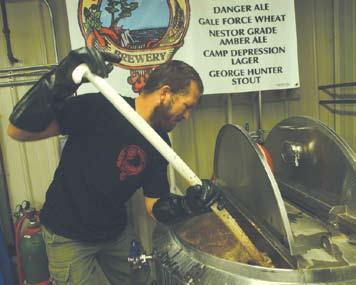
His small brewery sits where an old shower building once stood.
The young couple is raising a pair of boys (ages 4 and 2) next door in the house her great grandfather built about 100 years ago.
“We get to see each other a lot,” Jamie MacFarlane said. “Our two boys are the fifth generation to live in the house. I wanted to raise a family here. We have breathing room. I would never choose to live anywhere else.”
Clint MacFarlane recently hired Mason Williams to

help out with the brewing, which is currently done twice a week, though he’ll soon be adding a third brewing day. MacFarlane, 33, still has responsibilities at the resort, so hiring somebody to help with brewing became a necessity. Demand for the beer exceeded supply.
“We thought we might expand in five years,” he said.
Recalled Jamie MacFarlane: “We were like, ‘Let’s see how the North Shore reacts to it. Let’s see if the North Shore likes the beer.’”
It was instantly popular. There’s a waiting list of bars and restaurants up and down the North Shore that want to serve the beer.
Several businesses have the beer on tap in Two Harbors, including The Rustic Inn and Grand Superior Lodge, and it also is on tap at Crossing at Cove Point Lodge in Beaver Bay, Lighthouse at Emily's in Knife River and Boathouse Brewpub in Ely. Find a complete list at www.castledangerbrewery.com.
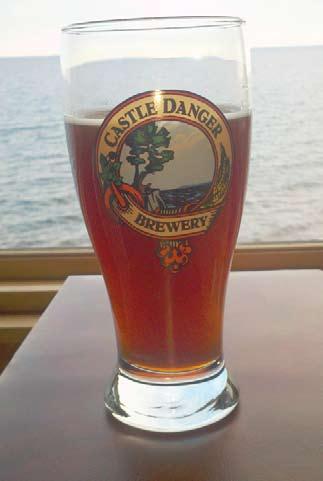
ing tanks (as well as a mash tun, brew kettle and brite tank) and quickly added another.
“We’re trying to take care of everybody local first,” MacFarlane said, noting that he ultimately would like to expand into the Cities.
On Wednesday, Friday and Saturday afternoons, the brewery (3067 E. Castle Danger Rd., Two Harbors) opens up to the public, which can sample the beers on tap and purchase fresh growlers full of the beer and merchandise.
There’s typically a fair amount of traffic during public hours.
Word has traveled throughout the state, but MacFarlane can’t make the beer fast enough.
He initially started out with a pair of ferment-
He recently placed an order for a fourth fermenter and a second brite.
“That’s just to bridge the gap,” said Williams. Williams was referring to plans to expand production with a brewery in downtown Two Harbors in 2014, the details of which haven’t been finalized.
But MacFarlane plans to keep his current tanks where they are after the expansion.
“We keep thinking it will slow down, but it hasn’t,” said MacFarlane. “Right now, we’re making the stuff as fast as we can sell it.”

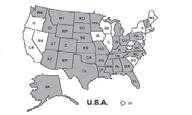

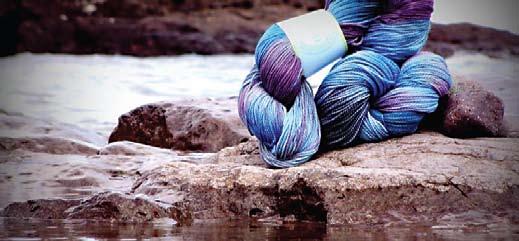
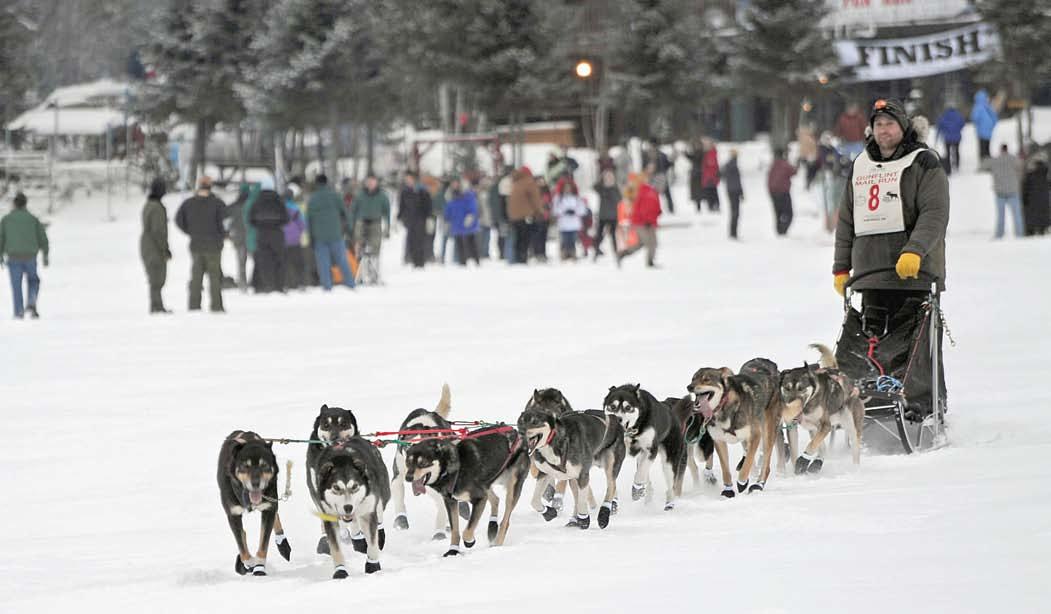
almost
By Javier Serna
Last year, t he threat of poor snow conditions — thanks to a mild winter — forced the cancellation of the John Beargrease Sled Dog Marathon and the WolfTrack Classic Sled Dog Race.
But with plenty of snow on the ground in Cook County, organizers scrambled to bring back the Gunflint Mail Run in the 11th hour.
“We put it together in 12 days,” said Jack Stone, board member of this year’s inaugaral Gichigami Express Sled Dog Race, an offshoot of last year’s impromptu chase.
Last winter is just another chapter in Minnesota’s long sled dog history.
This year, there’ll be three sled dog races in Minnesota if the snow allows.
Last year’s Gunflint Mail Run highlighted the need for a race that celebrated Cook County’s sled dog cultures, said Stone, who owns and operates Stone Harbor Wilderness Supply in Grand Marais.
“We’re not looking to compete with the Beargrease,” said Stone, acknowledging the established 400-miler does course through Cook County. “We were just looking for something that was more Cook County-centric.”
The original Gunflint Mail Run actually preceded the Beargrease, and was last run in 2007, when the Beargrease was cancelled.
But unlike last year’s roughly 100-mile Gunflint Mail Run, which was a marathon, the Gichigami is a stage race, with three 60-mile segments.
The 180-mile Gichigami Express will celebrate the three distinct sled dog histories in Cook County: Grand Portage, Grand Marais and the Gunflint Trail.
“The race is designed to be an educational, cultural event,” Stone said. “In all three places, sled dogs were used for transportation, for mail, for supplies.”
The race begins on Jan. 6 in Grand Portage,
where fur traders, loggers and early settlers used sled dogs to get around.
The Grand Portage Band of the Minnesota Chippewa Tribe has put up a $25,000 purse for the event, which is limited to 30 mushers.
The three-day event is spectator friendly, and there are several opportunities for the public to interact with the mushers.
The night before the race at the Grand Portage Community Center, there will be a public potlatch dinner, showing the relationship-building Ojibwe custom of a feast and exchange of gifts between members of the community and the mushers.
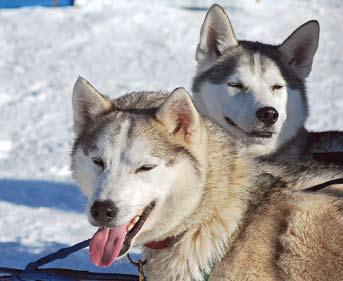
This race, originally started in the Ely area in 2008, was also a casualty of last year’s mild winter.
“It finally snowed the day of the race, but by that time it was too late,” said president Randy Scott.
This year, the Classic, which also has two races, has been shortened. The longer race, which had been 120 miles in the past, will be 60 miles, and proceed from Ely to Tower and Cook.
This is also the last of the state’s three races, a two-day event beginning Feb. 23.
On the first day of the race, after the mushers will have raced from Grand Portage to Trail Center, there will be a barbecue dinner, and the mushers will talk about the sled dog culture on the Gunflint Trail.
The next morning, mushers will race to Devil’s Track Lake. Dinner will be served at
American Legion in downtown Grand Marais.
There will be an awards banquet at the Grand Portage Lodge on Tuesday, after the final leg.
“These events will be intimate,” Stone said. “All the mushers will be there and you will be able to walk right up to them and talk with them. We want people to do that.”
There was a lot of disappointment when the Beargrease, which originates in Duluth, was cancelled last winter.
“Hopefully we don’t have a repeat of that,” said race director Pat Olson.
At 400 miles, the Beargrease is the longest sled dog race in the lower 48 states, as it races from Duluth to Trail Center and back.
The Beargrease celebrates the life of Anishinaabe fur trapper John Beargrease, who was the winter mail carrier between Two Harbors and Grand Marais for 20 years before he died in 1910.
It draws some 800 volunteers, and spectators are given ample opportunity to view the race on top of several signature events centered around the mushers, such as the gala fundraiser on the Friday night before the race. On Saturday, the public is invited to the veterinarian checks, and there’s a cutest puppy contest as well as the opening ceremonies, where the starting order is drawn.
There are actually two different races that are part of the Beargrease, a shorter mid-distance race capped at 30 mushers, and the marathon, which has a cap of 50 mushers.
The teams start with a maximum of 14 or a minimum of 10 dogs and must finish with a minimum of five dogs. Dogs that leave the race may not return, nor can fresh dogs be added.
It’s a grueling endurance race that inspires a lot of people, Olson said.
“That’s what keeps me coming back,” she said. “It’s this amazing relationship between humans and dogs. … You can see the heart these dogs have and it just grabs you.”
As is the case with all three races, there are many opportunities for spectators to view the dogs, and maps will be available showing all the road crossings, said vice president Theo Theobald.
Ely, which once hosted the pre-cursor to the Iditarod, called the All-American Sweepstakes, also has its own vibrant sled dog culture and is home to six sled dog outfitters, Theobald said.
“Ely has a long history of Arctic travels,” said Theobald, who is a musher.
Theobald said the WolfTrack Classic is a great race for beginners to try.



By Bryan Hansel
As Highway 61 runs from Duluth to Thunder Bay, it travels by an eroded and ancient mountain range. The remains of the mountains provide steep hills, sheltered valleys and, because the snow is reliable on the North Shore, consistently good cross country skiing.
If there’s a mecca of cross country skiing in the Midwest, this is it. There’s more than 700 kilometers of groomed cross country ski trails ranging from easy to advanced. Because there are so many trails, it helps to know the best ones to hit on your visit. Here are a few of my favorites.
Located near the Duluth airport, Snowflake Nordic Center offers more than 15 kilometers of groomed trails, mostly intermediate to advanced, and includes lighted skiing for people that want to get out after dark. Because it’s a ski center, skiers can also get instruction and rentals right at the trailhead. While the snow isn’t as consistent in the Duluth area as it is up the Shore, Snowflake often has the best snow in Duluth and it has expert grooming. A daily trail pass runs $7 with seasonal passes starting at $117.77
While other state parks on the North Shore offer cross country skiing, none of them give the thrills of Tettegouche State Park, which has a screaming scary downhill on every trail. On the lower loop trail, which you access from the park, you can ski to Nipisiquit Lake, a tranquil lake that feels far away from the business of workaday life. It’s the perfect place for a picnic and to contemplate your frozen breath.
The Great Minnesota Ski Pass is required for many ski areas on the North Shore. Daily rates run $6 and a season pass is $20. You can get a ski pass anywhere you can buy hunting and fishing licenses or online at http://www.dnr. state.mn.us/licenses/skipass/index.html.

While I think these seven locations are the best of Highway 61 cross-country skiing, real ski junkies should buy Andrew Slade’s Skiing the North Shore. In it, Slade writes about all the cross-country ski systems on Minnesota’s side of the border.
The Sugarbush Trail system offers about 70 kilometers of trails that you access from three different trailheads. The Britton Peak trailhead offers easy terrain and beginner trails just a short drive out of Tofte. Near Lutsen, the Onion River trailhead offers easy access to beginner trails on Onion River Road and the intermediate Oberg and Homestead loops. For serious adventurers, the Picnic Loop is a nice 25-kilometer outing. Pack a lunch, stay out all day and watch for wolf tracks. By headlamp one night, I chased one down the trail in front of me.
While not a designated cross country skiing area, skiing up the Devil Track River from Highway 61 feels like a beginner trail until the red rhyolite canyon walls narrow and grow to 200-feet high. At that point, the terrain climbs over frozen cascades and feels like an intermediate to advanced trail. Don’t let that fool you though, because you’ll be almost two kilometers into a hard-to-access canyon while skiing on a river next to open water in places – it’s expert-only terrain. When you reach Barrier Falls, an 80-foot tall frozen waterfall that blocks forward progress, turn around and ski back to the highway. For advanced skiers with river rescue skills, consider a one-way trip with a mandatory rappel from the Gunflint Trail to the highway.
Just a few minutes up the Gunflint Trail from Grand Marais, the Pincushion Mountain trail system has 25 kilometers of expertly groomed trails that run through a predominately birch, spruce and fir forest. There’s not a bad trail in the system, but the stars are the North Advanced loop, the Pincushion Mountain loop
and Canyon Curves. You can combine the three for a 14-kilometer outing and see the best the system offers, including a view into the 200-feet deep Devil Track canyon and if you stop, a view of Lake Superior from Pincushion Mountain, which feels like the top of the world.
This ski route, a combination of downhill skiing and cross country, takes you from the inland Deeryard skiing area, located off County Road 45, to Cascade Lodge near Lake Superior. Depending on how you play it, you could ski 12 or more kilometers with the majority heading downhill. Once you get into the Cascade Lodge area, ski 500 feet up Lookout Mountain for a view of Lake Superior and more downhill fun on the return trip.
While not exactly on Highway 61, it’s close enough for a skier who wants to both see the “Niagara Falls of the North” and ski. Kakabeka Falls, located in Ontario’s Kakabeka Falls Provincial Park, offers three loops that total 13 kilometers. The trails range from beginner to intermediate. The trailhead is near the 120-foot Kakabeka waterfall.
By Dave Nelson of Lutsen
Out on Trout Lake, I can’t feel my toesCould it be that they are froze?
My snowshoe tracks leave a trailI’m not in a fish house, just on a pail, Fingers are freezing at fourteen above, Why the heck do they make fingerless gloves?
The wind blows snow and fills up the hole, I wonder…is it time to pack in my pole?
There goes my line, it disappears out of sight -
Quickly I set my hook on the bite, Dropping my mitts, I grab for the line,
A keeper trout would be just fine!
Hand over hand, don’t bother to reel -
A big one, I can judge by the feel!
Diving for bottom in fifty feet, I pull line again, not missing a beat.
Splashing and circling in the frigid hole, Landing this fish, on the end of my pole.
My numbed fingers now clench a laker Sometimes released, but today it’s a baker.



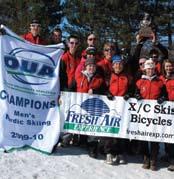
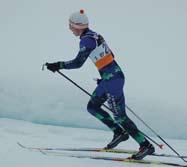

By Lee Boyt
Here you are, in one of the most breathtakingly-beautiful places in the Northern Hemisphere, taking a welcome respite from work and the ol’ hometown. Vacationing in the winter is great – no crowded beaches, low humidity, no mosquitoes, air so cold your nose hairs ice up when you inhale. This is the life.
The family watches the snow from the motel room window – four days and nights of snow carpet-bombing the area. See the sights? You can’t even see your car, much less take in the tourist traps. There aren’t many signs of life outside, except all those snowmobiles zipping around, their pilots oblivious to the meteorological mess.
Man, wouldn’t it be nice to have a couple sleds right about now? How about renting a pair of late-model snow machines, load up your posse and cross over into the fun zone? It’s just a phone call away. Hungry Jack Lodge (218-388-2265) on the Gunflint Trail, Beaver Bay Sports (218-226-4666) in Beaver Bay, and Steve’s Sports & Auto (218-387-1835) in Grand Marais, all offer a rental service.
Minnesota has over 22,000 miles of snowmobile trails, and usually plenty of snow, so the big question isn’t what to do, it’s where do we want to go to do it.
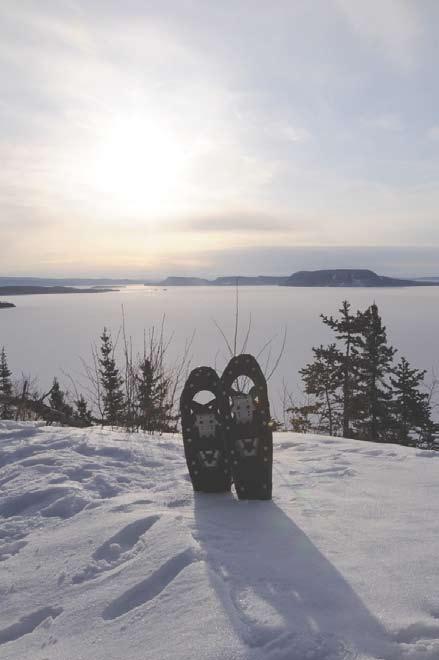
Although the sheer volume of the white precipitation might be intimidating, the ambient air temperatures are tolerable, if
you’re wearing warm clothes.
And renting a sled is considerably more cost-effective than buying a snowmobile, a trailer, licenses and fees, not to mention the hassle-factor of trailering your personal machine 1,000 miles each way. Nope, renting is the way to go.
If you’re an experienced snowmobiler, you can skim over this part; however, if you’re new to the sport, there are some things you need to know.
Familiarize yourself with the “Rules of the Road” for snowmobiles. If you drive a car, you can operate a sled. The traffic management principles, signage, and safety practices are pretty much the same on the highway as they are on the trail.
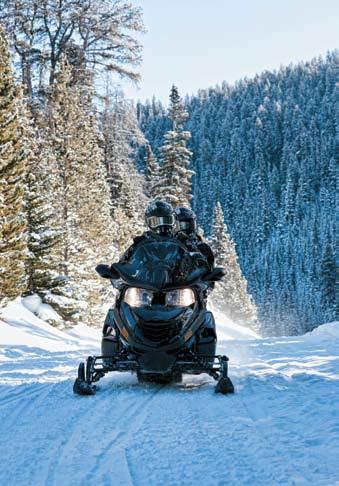
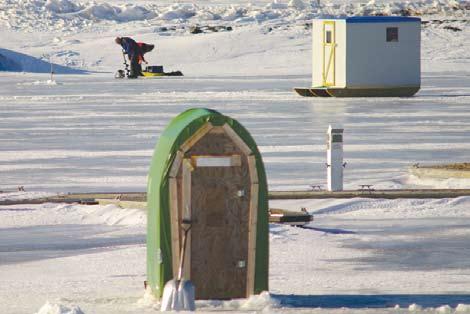







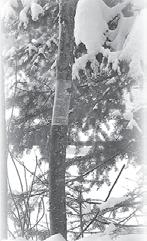




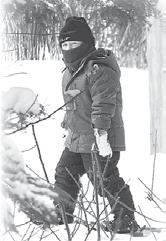

Before you pick up your rental machine, check out the Minnesota DNR snowmobile site (www.dnr.state.mn.us/snowmobiling/index. html) for safety tips, trail conditions, and all kinds of good sled-related information.
Well, there you have it. Watch TV and eat soggy pizza, or get up, get out, and hit the trails. Tough choice, right?
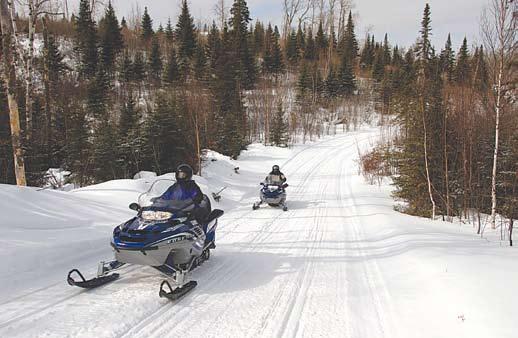
We consulted snowmobile rental operator Steve Lashinski, owner of Steve’s Sports & Auto in Grand Marais, for his behind-the-scenes observations and common sense guidance. Here are some of the questions we (NW) asked, and Steve’s (SL) paraphrased recommendations:
NW: When someone calls about renting a snowmobile, what’s the most important thing you tell the prospective customer?
SL: I tell them to wear layers of water-resistant warm clothes; waterproof, insulated, hightop winter boots, and heavy, water-resistant gloves with extra-long cuffs. It gets miserable real fast if you’re cold and wet – and that’s no fun.
NW: What about helmets?
SL: We rent insulated snowmobile helmets here, so that’s not a problem.
Note: Some snowmobile centers rent not only sleds, but complete snowmobile suits, boots, gloves, and helmets as well
NW: Let’s say we walk into your store and want to rent a sled, but aren’t sure what type of machine we need. What should we be looking for in a rental machine?
SL: You’ll have to decide if you want a one-person (“oneup”) or two-person (“twoup”) snowmobile. A majority of our rental customers are families – mom, dad, and a couple kids – so two-ups are pretty popular. Plus, the twoup is going to give you a more comfortable ride, because the frame on a two-up machine is physically longer than a one-seater; it’ll smooth out washboard/bumpy trails better than a shorter single seat snowmobile.
Look for a late-model machine with all the bells and whistles – electric start, reverse drive, hand warmers, and a high windshield. Our sleds are three - four - years old, max. We have a multiline, full-service dealership, so the rentals get regular professional maintenance.
NW: Do you just hand over the keys or is there some kind of walkaround with the customer?
SL: After the paperwork and credit card business is done, we give the customer a thorough orientation, covering the basics— control locations, how to use the various features, how to check the oil and fill up the gas tank – then one of us demonstrates how to change a belt and spark plugs, just in case. Every rental leaves here with spare belts, plugs and a few tools.
We’ll have the customer drive the sled around the lot a couple of times to get familiar with the machine before we turn ‘em loose.
If a client is relatively new to snowmobiling, we’ll take the time to give them a simple refresher course on how to operate the machine; afterwards the customer is more confident and we’re more comfortable letting the sled drive off the lot.
NW: Anything else you’d like to add?
SL: Be careful. Be responsible. Absolutely do not drink and drive — nothing good comes of it. Oh, and don’t forget to have fun.
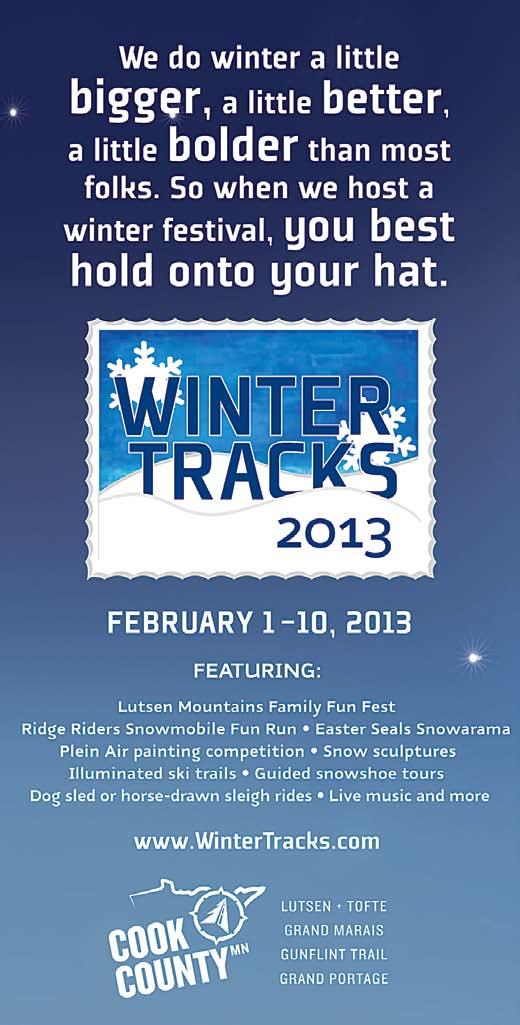
Because of the dangers, it’s an experts-only endeavor
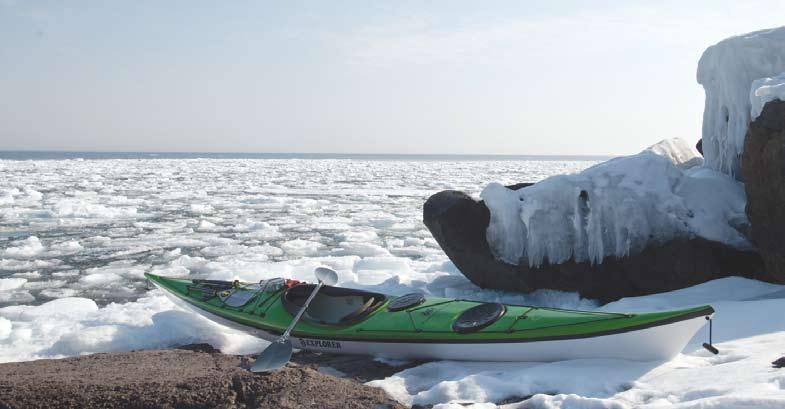
By Bryan Hansel
My friend’s white sea kayak matches the fresh snow he just placed it on. The snow that fell overnight is ankle deep and covers shoreline right down to a 5-foot sheet of bluish fast ice. I get into my kayak, stretch my neoprene sprayskirt around the kayak’s cockpit, grab my paddle and push off.
The kayak glides silently down the snow to the fast ice. As I slide across the ice, I cringe at the crunching sounds it makes, and then my bow touches water and as the rest of the kayak follows, it wants to capsize, so I brace and the kayak comes back upright. There’s a field of pancake ice, circular pieces of ice formed by
wave action, floating a couple of kayak lengths away from the shore. My friend works his way through the ice, cutting a path, which I follow until we’re into open water in the Grand Marais harbor.
Winter kayaking on Lake Superior offers sights and sounds not seen the rest of the year, but it also offers more dangers and only the most experienced and expert-level kayakers with the right equipment should attempt it. Even then, the risk of death is a real possibility, and the chance of rescue by an outside group is slim to none. With that in mind here is the type of gear that you need to attempt this.
Sea Kayak: A sea kayak with bulkheads adds safety to your trip, because if you do capsize,

fail a roll and go swimming, the kayak still floats and it fills with a limited amount of water. A paddling partner then can perform an assisted rescue.
Paddling Partner: The safety of winter sea kayaking is marginal, so you should always kayak with one or more competent partners that have the skills to both rescue you and rescue themselves.
Drysuit: Drysuits keep you completely dry if you fall in, but they have limited insulation, so you need to layer a bunch of clothing underneath in order to stay warm. The general rule is you need to dress for immersion, which means you need to wear enough insulation under a drysuit to stay warm when swimming in the water.
Life vest: Wearing a life vest is a must, because it helps keep your head above water if you suffer cold shock, which is an uncontrollable gasp reflex that can lead to drowning. The life vest also helps save your energy should you end up
in the water and need to be rescued by a paddling partner.
Neoprene hood, mittens and boots: Neoprene hoods help protect you from cold shock by keeping the cold water from hitting your bare skin and neoprene gloves or mittens help keep your hands warm. I like mittens, because they’re warmer. I recommend a drysuit with Gore-Tex socks, but even with socks, having neoprene boots really helps to keep your feet warm.
Rescue Stirrup: A rescue stirrup is a circular length of rope that you drape over a kayak's cockpit and use as a step to help someone get back into the kayak. It’s useful when you don’t have enough strength to get into the boat with just your arms.
Ice picks: Getting out of the water onto ice is difficult. Ice picks stick into the ice and give you something solid to grab onto, so you can pull yourself out.
Other gear: You should always bring along your typical paddling kit with items such as a first aid kit, VHF radio, emergency signaling devices, pumps, paddlefloats, neoprene sprayskirt, tow rope, etc.
Unlike smaller lakes, Lake Superior produces Arctic Ocean-like sea ice. One of the pleasures of winter paddling is paddling through, around and landing on sea ice. Some types of ice you might encounter on Lake Superior in winter include the following.
Brash Ice: Fragments of larger floating ice not more than 6.5 feet across.
Fast Ice: Ice that remains fixed to the shore. It can be flat or appear as a wall.
Floe: A flat chunk of ice 65 feet or more across. If thick enough, you can land a kayak on these and take a hike.
Grease Ice: Newly-formed, but soupy ice that gives the lake a matte appearance.
Pack Ice: A general term used to describe all types of ice floating on the big lake.
Pancake Ice: Circular ice up to 10 feet in diameter created by wave action. It looks like a field of pancakes.


There are Holy Grails for a lot of things in this world.
In professional hockey, it would be the Stanley Cup. In Canadian football, the Grey Cup.
Trout fishing? Well, my vote would be for the rod that caught the world record brook trout from the Nipigon River, on July 21, 1915.

By GoRD ELLIS

That fish was caught by Dr. J.W. Cook of Fort William, Ontario, and weighed 14.5 pounds. It is the longest surviving all-tackle fishing record still on the books. It’s also a world record that will likely never be broken. Amazingly, although it’s been just over 97 years since that huge brookie was caught, the rod it was caught with still exists.
It is owned by Jim Donaldson, a Thunder Bay dentist and avid trout angler. Recently, he invited me to see his most cherished fishing item. Best of all, he told me the story of how this historic fly rod found its way into his hands.
“I had seen this rod many, many times as a youngster,” says Donaldson. “The person who lived right around the corner from us was a nephew of Dr. Cook.” Donaldson says Cook’s nephew had no children and was intolerant of kids. But occasionally, they would work up the courage to knock on the door and he would let them hold the rod. Donaldson and the other trout crazy kids knew that the rod had caught the world’s biggest speckled trout. It was a thrilling thing for them.
Donaldson says he next heard about the rod years later.
“I was at an auction sale and there was an oak refrigerator being auc-
tioned off,” he says. “I outbid a patient of mine who is an antique dealer. My plans were to turn it into a liquor cabinet for my camp but the dimensions weren’t going to work out properly. Then one day he came into the office and handed me Dr. Cook's rod and said ‘we’re even.’ So he took the oak icebox and I got the rod.”
At first glance, Dr.Cook’s ancient rod looks like it could be a very expensive re-creation. It really is in remarkable shape. Donaldson has it displayed in sections, with the original carrying case
“It’s a 6-section bamboo rod, probably tonkin cane,” says Donaldson. He says the actual age of the rod is unknown, as he says there were no dates or company names on rods of that era.
“I’ve shown it to a few people, and nobody knows who actually built the rod,” he says. There is, however, one discernible name on the rod, and that is the signature of Dr. Cook. Donaldson points out the red, white and black windings on the rod and notes the relative closeness of them. He says that was to help provide strength that would have made up for the deficiencies in the glues of the day. There are also a couple of guides on the tip that are starting to fray and the upper ferrule is loose. The rod handle is cork, and covered with adhesive tape. Donaldson says repairs to the legendary rod would be simple to do, but he’s been told fixing it could decrease the value of the rod. Dr. Cook’s fly rod looks much like it probably did when he unwrapped it on Rabbit Rapids that fateful July
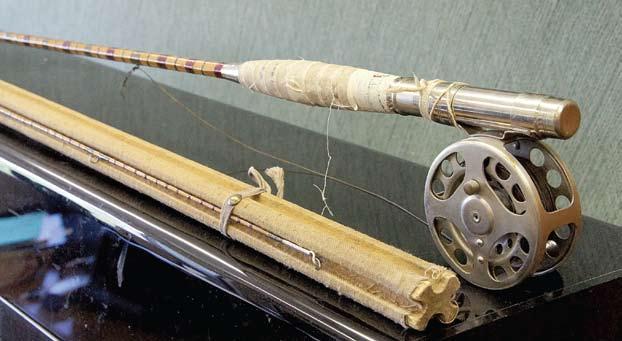
day almost 100 years ago.
The fly reel is made of plated brass. Similar to the rod, there are no manufacturer names or markings on it. “We don’t know who made the reel either,” says Donaldson. The original fly line is still on the rod. It is silk with varnish on it. Donaldson says he’s unsure whether the line was floating or sinking as he’s never dropped the line in the water. “I probably never will,” he says with a chuckle.
The rod, though solid, is rather light. Donaldson says it would probably be similar to a 5-or 6weight modern fly rod. The lightness of the rod, coupled with the size of the fish and the great current of the Nipigon River, makes it a wonder that Dr. Cook was able to land a nearly 15-pound brook trout on such a rod. It must have been a great challenge, and thrilling beyond belief.
Donaldson know there have been a lot of stories told around Dr. Cook's world-record fish. There are rumors that Cook used a spoon, or a live minnow, and not a fly to catch the fish. The minnow story was perpetuated by a news story from 1949, reprinted in the book “Paddle, Pack and Speckled Trout” that quoted Dr. Cook as saying he was using a minnow. There are also the long-whispered rumors that one of Dr. Cook’s Ojibwe guides actually caught the trout. Simply put, there are no instant replays or pictures to prove or disprove any of the tales.
Thanks to river log books, we do know for sure that Dr. Cook was on the river the day the world-record fish was caught, and that he brought it to Nipigon to be weighed. In those early days, fly fishing was the most common way to fish for brook trout in the Nipigon. No one seems to argue that Dr. Cook used the fly rod bearing his name.
Donaldson says the giant brook trout was also given quite a bit of attention even way back then. The fish was so unusually large that its skin was sent to Ottawa and Washington for ichthyologic identification. The mount of the fish was displayed in Fort William, and then Nipigon, for many years. Sadly, it was in the town's museum when the building caught fire in 1990. The mount was badly damaged in that fire, but the surviving remains are apparently housed at the new museum in Nipigon.
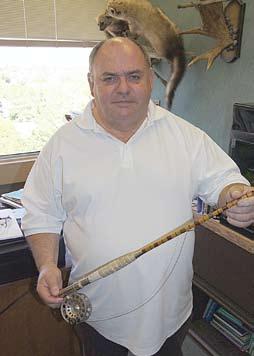
to the appropriate — most likely American —collector.”
So the other big question everyone wants to know is — how much is the rod worth?
“If my wife knew what the potential value of the rod is, she probably would have sold it on me a long time ago,” he says with a grin. “ I’ve heard figures up to $40,000
However, those collectors are just going to have to lick their lips. Donaldson says he has no interest in parting with this legendary piece of angling history. If anyone gets it, it will likely be his son, who is also an avid fly angler and trout fisherman.
“It’s a cool thing to have,” says Donaldson, as he cradles the rod in his hands. “For sure.”
By Javier Serna
The ice will be here soon.
Some of us can hardly wait.
Last year’s short season certainly didn’t help those of us afflicted with a bent towards hardwater fishing.
We’ll be making up for it this year. And that means more gear. Because getting new stuff is half the fun of ice season, and the industry keeps improving their products to give you an edge.
Here’s a handful of new items — far from a complete list — geared towards walleye and trout anglers:
There’s probably more new color patterns available this year than new lures.
JR’s Tackle re-launched most of its offerings in the UV Glowin’ Glitter colors, which are likely to be a hit this season.
But there are a handful of new baits.
Bemidji-based Northland Tackle introduced the Whistler prop spoon ($6.99) this year, which comes in sizes that should appeal to anglers chasing walleyes or trout.
Northland Tackle also entered the Tungsten market, pouring a new line of its Fireball jig ($3.69) with the heavier metal, which allows anglers to get down to hot-biting fish with a smaller jig.



Lindy has added the Foo Flyer ($2.69), a take on the old airplane jig, with a tear-drop shape that makes it swim. It comes in four sizes from 1/16- to ¼-ounce, covering you from crappie to walleye.
For those looking to get down to deep Lake Superior lake trout, or even deep inland water, there’s been a shift to saltwater jigging spoons. The Braid Slammer ($6.99-7.99) is made in sizes up to a pound, but here a one-, two- or three-ounce version will do.
Frabill’s Jiggler Long Rod ($39.99) is a rod and reel combo that’s different, combining the ease of a fly-fishing style reel that T-bones the rod, and the fishing line runs through the rod for extra feel. St. Croix has updated the look of its Premier ice fishing rods ($25-40), which feature traditional cork handles and are made in a range of sizes, from ultra-light to heavy.
Clam’s new Dave Genz split-handle rods ($29.99) have their graphite blank partially exposed in the handle for extra sensitivity, and are made as heavy as a 40-inch heavy action for lakers.

It’s not a rod or reel, but Frabill’s Calibrator Line Counter Tip Up ($39.99) has a digital screen that will tell you how much line is out.
Probably the most eye-catching auger to hit the market is the green ION electric ice auger It’ll drill 40 holes (8 inches) through two feet of ice on one charge to its 40-volt lithium battery. It weighs 22 pounds.
For those heading into the Boundary Waters, where power augers aren’t allowed, the Strikemaster Lazer Synthetic Ultra-Lite hand auguer ($149-169.99) is tops on the hand auger market. It’s available in four- and six-inch models, and both come with cushioned handles. Both are light at 4 ½- and 5-pounds, respectively. It also has an adjustable shaft, which extends to 57 inches, in case you need to get a little bit deeper.
If you want to go gas, but are still looking to
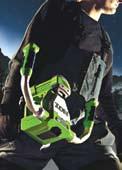
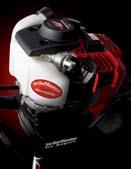
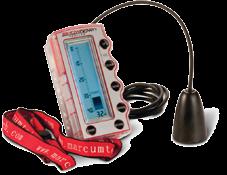
lighten the load, Strikemaster just released a new four-stroke, the Honda 35cc Lite ($569.99), which weighs 23 pounds
Your pocketbook can breathe, or can it?
MarCum released the LX-6 digital sonar system ($599.99), which is $100 cheaper than the LX-7 and has a six-inch screen that’s two inches smaller than its larger predecessor. Marcum also released the LX-9 sonar/camera system, which puts a flasher and underwater camera on the same screen. But it’ll also put you back $1,199.
Vexilar has come out with a new, batteryoperated light, the cordless L-202 Flex Lite ($19.99), which bolts to its flasher packs and runs on its own AA battery.
Marcum has also come up with a lower-priced hand-held depth finder called the Showdown Troller digital sonar system ($199.99). It runs on a pair of AA batteries and is designed for quick checks on holes.
Clam Outdoors is seeking to tackle party fishing with a pair of shelters. There’s the Switchback expand able hub shelter ($349.99), which expands from a threeman shelter to a six-man shelter. There’s also the roomy Six-Pack hub shelter ($299.99-379.99), which is made for six people. Frabill improved its hub shelters to include the insulated Thermal fabric ($229.99-$399.99).

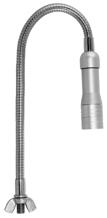

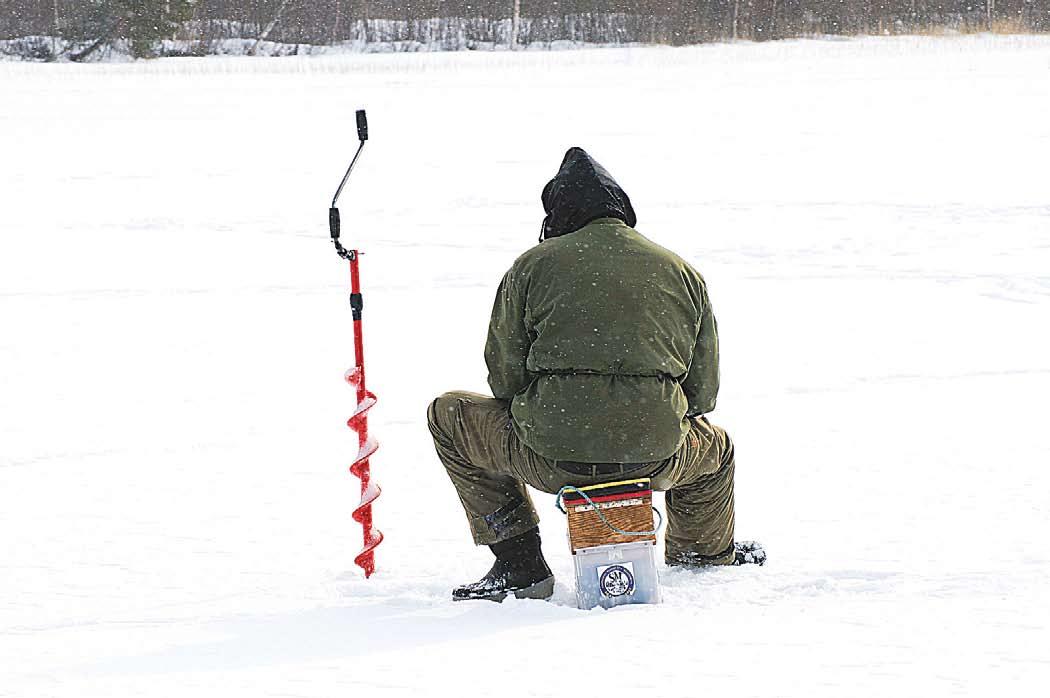
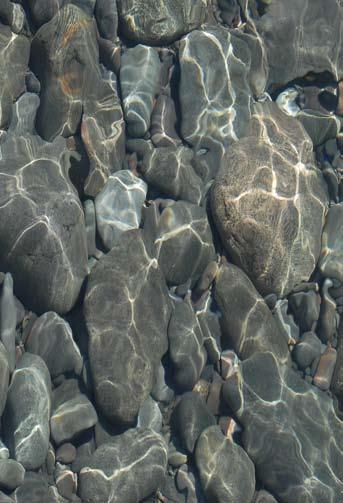
The only local radio station
* Local information and events
* Local music and entertainment
* Programming that reflects area on Minnesota’s North Shore
Radio arts, history, and culture
- Whole Leaf Tea - Gourmet Soups - Bakery Goods - Homemade Sandwiches individual
beans for your locally owned Dunn Bros Coffee Stores. Each single-origin bean reflects the unique nuances of the farm where it was grown. We take great joy in offering different varieties of coffee roasted daily in our store.

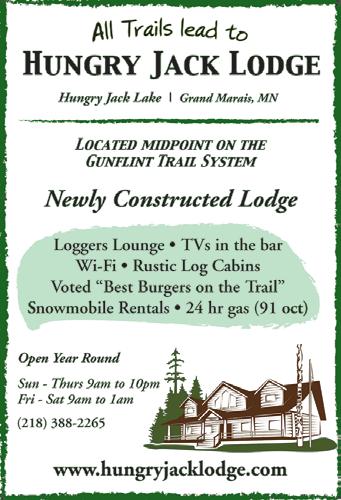




We Northlanders are a hardy bunch, and so are the critters that share our region. I’m sure we all have friends and relatives that live in warmer climes who remark that they don’t know why we live here.
We live here because we love it, love the bright starkness of a snowy winter scene, the incredible silence of the winter woods, and enjoy following the tracks of wildlife after a fresh snow. Though some may think that winter is a slow time for wildlife photography, it actually is one of my busiest seasons.
Without the barrier of leaves, with the tall grass beaten down by snow, animals are much easier to see and photograph, and the labyrinth of tracks they leave are a virtual encyclopedia of which animals exist in that neighborhood. Birds are more easily spotted, and with food sources concentrated, such as on conifers, the hunt for them can be dramatically easier.
Winter does present challenges, both for you and your equipment.
Staying warm in winter can be tough, but dressing in layers is one method to beat the cold. And like a hunter, you should wear clothing that is quiet. You need to be able to hear animals and birds and minimize how much they can hear you – rustling nylon is amazingly loud in the winter woods. I lean toward traditional fabrics and insulation – wool pants are my favorite. I like down-insulated jackets or parkas because not only are they warm, they breathe better than synthetics, and the compressibility of the down makes the garment less restrictive when worn in the vehicle. Camouflage is always a good idea for wildlife photography. Waterproof, insulated footwear is a must. While pack boots are the warmest, I find them awkward for both driving and walking quietly, so I have switched to wearing hunting boots with at least 800 grams of Thinsulatetype insulation. The narrower profile of these boots make for less cumbersome driving, and they fit snowshoe bindings more easily.
The biggest challenge is keeping your hands warm. You need to be able to feel the shutter button and be able to ma-

By MICHAEL FuRTMAN

nipulate all those other buttons and rotate dials, too. I wear a warm glove or mitten on my left hand, since that one is usually just holding the lens barrel, and a thin liner glove on my right. I then tuck a chemical hand-warmer in the glove on the back of my hand. Reverse this if you’re left handed.

Even when in your vehicle, you may need to bundle up. A car or truck makes a wonderful photo blind, because many animals are so used to seeing them that they virtually ignore them. A great many of my best shots were taken right out the truck window. But — and this is very important — you can’t have the engine (and thus, heater) running. First, the sound of the engine can alert your subject. Second, the vibration of a running engine can cause camera shake. Third, heat shimmer escaping your window from a hot passenger compartment will ruin many images. I routinely open the passenger window while shooting to avoid this, and so the inside of my truck is generally the same temperature as the outside. I sometimes carry an old sleeping bag or parka to throw over my lap and legs while shooting from a vehicle.
I get many questions about whether our extreme cold will harm your photo gear. I’ve been out in 20 below zero weather without causing any damage. In fact, since virtually every camera is now digital, the biggest worry I once had — film breaking in the cold — has been eliminated. You may occasion-
ally get a weird error message from your camera, and that is almost always due to a frost buildup between the lens and the camera body (if using a dSLR). Usually detaching and reattaching the lens solves the problem.
Batteries don’t last as long in the cold, so make sure you have a spare, and keep it in an inside pocket where it’ll stay warm — and when a battery runs down, move it into an inside pocket, too. You may be surprised that it really wasn’t completely dead, just frozen. Be careful not to rapidly bring an icecold camera into a hot vehicle or house, or it may fog up the lens. Not a big deal if it is just the lens surface because you can just wipe it clear. But sometimes you’ll fog the interior of your lens, and there is no way to quickly clear that so that you can continue shooting. You’ll need to bring that lens indoors, and set it in a sunny window or near a radiator for several hours before that fog will clear.
Despite the challenges of photographing in winter, it is a great time for those who love to photograph wildlife.

Mysterious triangular-shaped stone holes embedded in large boulders have been identified in more than 200 sites worldwide, including Minnesota, the Dakotas, Ontario, Manitoba, Quebec and western New York.
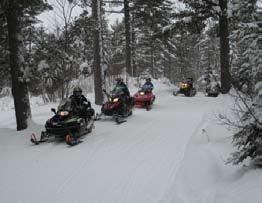

By ELLE ANDRA-WARNER

They’ve also been found in Iceland, Greenland, Scandinavia, Scotland and Wales. And the number of locations is growing each year, with one of the most recently discovered holes now being investigated in North Dakota.
The stone holes are not the easiest things to find, as the small holes are often only one to two-and-a-half inches in diameter and usually less than six inches deep. They are difficult to spot on large boulders. Wherever they are found — there is a strong similarity in these stone holes.
The stone-holed rocks found beside a lake or pond could be the hand-chiseled signature of “mooring stones” used in medieval Norway, Wales, Iceland or places where Norse ships may have been anchored with lines to the stone-holes. These kinds of stones have also been found along shores of Lake Nipigon, Lake Winnipeg and Sloops Cave/Churchill and Minnesota’s Cormorant Lake.
But what about the stone holes found inland on dry land
in the interior of North America?
Who made them, when and why?
In the past 20 years, the stones have caught the attention of people on both sides of the Atlantic.
One such person is South Dakota’s Judi Rudebusch, who has been a leader in research, gathering information and connecting globally with other stone hole researchers.
“Using GPS and survey maps, we plotted over 200 sites worldwide where this type of hole is found, and the mapping is continuing to this day,” said Rudebusch. “We sent out maps to land owners or we physically had GPS positions taken by either ourselves or others who are working on the project.”
In her home state, there are more than 50 rock sites in the Whetstone Valley in upper eastern South Dakota.
“In the course of my sending GPS readings around the world to others who were interested, I came in contact with a researcher in Iceland named Valdimar Samuelsson. He has spent years studying the ancient cairns, both in Iceland and the east coast of America. Upon seeing my charts, he brought to the forefront the idea of these stones with holes may have been used as possible boundary markers,” said Rudebusch. “Samuelsson suggested books
that dealt with stones used for land boundaries, marking stones and witness stones. Such stones are extensively addressed in the old law books of Iceland and Norway.”
According to Samuelsson, holed stones had been used in Iceland since A.D. 830 and are similar to the ones found in North America. In the article, “These Stones With Holes Have More to Tell,” co-authored by Rudebusch, he wrote, “The Icelanders made many trips west of Iceland as shown in the [old] Icelandic Annals and Diplomas. Some trips mentioned going west that used the term ‘years’ for how long they were gone. ... Could they have been surveying this new land?”
One of the theories that is linked to the holed stones in the interior of North America is that they were made by medieval Nordic explorer-traders. Theories have been around for many years about their early presence in the middle of the United States and Canada, arriving either by water highway systems from Hudson Bay, the St. Lawrence River, or overland trails to the interior starting in the Mohawk Valley in central New York.
“Many who come into this mystery become enchanted with the who, when and why of this question,” said Judi. Researches encourage people to join in the search for the mysterious stone hole boulders. Perhaps someday, the rocks will finally “talk” and tell their stories.
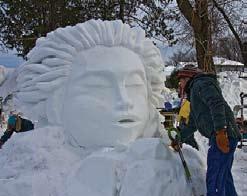




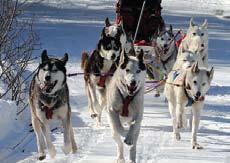

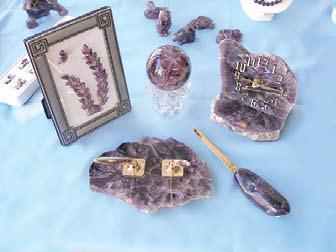
If you’re gardening on the North Shore, climate change has tapped you on the shoulder.




It’s here, it’s real, and it has arrived with unpredictable weather patterns, new insects and diseases as well as heavier infestations of familiar ones.
Gardeners are going to have rethink what they’re doing in order to grow their favorite vegetables, and there isn’t a very clear road map to follow — yet.

By JoAN FARNAM

“What’s normal anymore?” asks Diane Booth, Cook County Extension agent.
For the last five years, for example, spring has come earlier and earlier and warm temps have continued late into the fall. But it’s erratic. This year, for example, we’d have early spring highs of 60plus for a few days, and then drop down to the lower 40s for a week with freezing at night, and hike back up there a week later.
“You can’t trust that it will hold,” said Lise Abazs of Round River Farm in Finland.
And the same goes for fall temps. In normal times, by mid-October there would have been a couple of hard freezes and consistently cold temperatures so that the ground cooled down enough for the Abazs’ to use their root cellar.
Not this year. In early November, their root cellar was still too warm to store her carrots, Abazs said. She’s been forced to store them in coolers outside.
The unpredictable weather wreaks havoc with planting schedules, too. In May, it was so beautiful that everyone figured it was an early spring and planted. A week later, a cold front slammed in and seeds rotted in the ground.
And yes, this does sound like typical farmer/gardener complaints about the weather. We all know and accept that it’s a poker game, one way or another. But these are major changes and they’re bringing in new insects and diseases.
It was shocking this spring to discover tender carrots and beets and lettuce
plants that were popping up perfectly one day but were gone the next. Who was the culprit? Come to find out that a cutworm, called the variegated cutworm, native to Iowa, Oklahoma and other parts south, had been blown in by unseasonably warm winds and were feasting on everything they found in our gardens. Heck with feasting — they were mowing. Broccoli, cabbage and other brassicas were fair game, too. And these cutworms weren’t like the ones we were used to, which come out at night and cut the stems of plants off — collars around the base keep them away. No, these cutworms climbed things, and ate the growing nibs at the top of the plants and then everything else. Organic controls only worked if you caught them when they were small, and some gardeners, who were particularly hard-hit, collected basketfuls of the little beasts by digging around the base of every plant.
Meanwhile, these same warm winds from the south brought in an early hatch of leaf hoppers. These particular ones have the ability to pass on aster yellows, a horrible disease that affects more than 300 different vegetables and flowers, causing stunting, sterility, yellowing and more. The leaf hoppers arrived in Minnesota in force and attacked the only plant available to them that early in the season — garlic. Infected bulbs could not be planted for seed this fall because
they’re carriers of the disease.
“All the Midwestern growers were saying “Eat my garlic, but do not plant,” said Melinda Spinler, who was scrambling for seed garlic this fall. “Everybody in the nation was out of garlic (for planting),” she said.
But aster yellows also affected local production in peas, lettuce and carrots, to name a few. Flowers in the aster family, including purple prairie coneflower, suddenly started producing weird green flowers when they were infected by aster yellows.
No one knows what will happen next year.
What gardeners are now doing is rethinking everything. Row covers will keep out a lot of the insects, but they’re expensive.
And re-organizing planting dates and watering schedules when the weather is so erratic is really a challenge.
The good news? Tomatoes and squash were incredible this year. The variegated cutworms ignored them and they thrived in all that hot weather. A silver lining? Perhaps.
But then again, a healthy crop of garlic would be nice.

saysaid scrambling for the naplanting),” she local carrots, famconeflower, green aster next is rewill they’re and weather is squash variegated thrived lining? garlic change is

Anybody looking for a sturdy camp percolator that’ll serve multiple heads per brew should be pleased to own this stainless kettle. At about 2 pounds, it may not fit the bill for the backpacking crowd, but lighter percolators usually aren’t very durable. The Glacier was worth every extra ounce on a pair of canoe trips this fall to the Boundary Waters and down northwest Wisconsin’s Namekagon River. Most importantly, it brews a tasty cup of coffee, and, even using a medium grind, very few grounds found their way out of the basket, so the “cowboy coffee” quotient was down. It worked equally as well both over a fire and atop camp stoves. The entire device, from its handle down to its innards are built to last, though I should mention the swinging handle did come off a few times, though it snapped right back on undamaged. The Glacier retails for $59.95. www.gsioutdoors. com — Javier Serna

I can wear these everywhere. I usually have trouble finding sunglasses that not only perform, but look good, too. I’m happy to say these do both. The nylon frames are brushed with a beautiful wood grain, and the lenses have an amber tint. The light-weight frames fit securely on my head with just enough tension to keep from falling off while horsing-around, but not so tight that they were uncomfortable. The CR-39 polarized lenses are crystal clear, cut the glare, and have 100-percent UVA/UVB protection. Something to note: These sunglasses can also be ordered with prescription lenses or lenses with low profile bi-focal readers, eliminating the need for two pair of glasses while having fun in the sun. The sunglasses sell for $130. www.onos.com — Amber Pratt

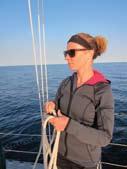
I think the sheep are laughing at us; they knew it all along. What makes the best fleece? Why, fleece, of course. In a departure from the standard polyester polarfleece jacket, Icebreaker created their “Real Fleece Line” — fleece jackets made of 100 percent wool. Far from a Jason and the Argonauts style sheep pelt, the Cascade Hoodie is made of soft merino wool with a fuzzy warm interior and a smooth outer face. I literally lived in it for months. It was the first thing I put on during chilly days and it looks none the worse for wear. Not only does it have all the merits of wool (breathable, no stink, warm when wet) but feminine seaming makes for an impeccable fit. A roomy hood and zippered hand pockets make the jacket a no-brainer for everyday wear, or layering or outdoor sports. The hoodie retails for $200. www.icebreaker.com — Kate Watson
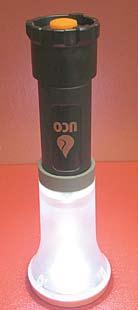
I tossed the UCO Clarus LED Lantern into my jacket pocket in October and have been happily impressed with its strong beam and collapsible lantern. Both proved invaluable on a late fall camping trip. Powered by three AAA batteries, the Clarus LED Lantern is slightly large for a pocket flashlight, but the slight increase in size is offset by the convenient lantern, which allows you to have hands-free light. You can adjust light levels from bright to dim. There is also an emergency strobe setting. After a month of regular use, I’m still on the original set of batteries. This flashlight is a good value at the MSRP of $19.99.—Shawn Perich
By Deborah Jo Larson
MINNESOTA
HISTORICAL PRESS, $16.95
Larson’s new hardcover children’s book tells the story of a grandfather and grandson and their ice fishing trip. Really, the book is more about the ambiance than the fishing, though its plot centers around the question: Will they catch a fish? It’s the author’s first picture book, though she has written for an online children’s magazine.
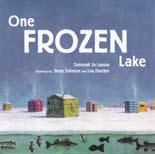
Steve Johnson and Lou Fancher illustrated the colorful book. They have collaborated on many children’s books, including Dr. Seuss’s My Many Colored Days and Garrison Keillor’s Cat, You Better Come Home. The pictures do as much to share the magic of ice fishing, through a child’s perspective, as Larson’s writing. One Frozen Lake would probably go a long way for any parent hoping to turn their young child onto ice fishing. — Javier Serna
Your Guide to Smoking Whitefish, Sauna Etiquette, Tick Extraction and More
By Chris Niskanen
MINNESOTA HISTORICAL PRESS, $19.95

Look into the future and imagine a world without fossil fuels — and no batteries or a power outlet. Just add water. Well, the hydrogen car may be a generation way, but the Bedol water clock hints at the potential of water as an energy source. Within seconds of filling the clear plastic clock with tap water, its LCD display screen starts working. There’s a pair of proprietary metal plates inside the device that convert ions in the water into current, which supplies energy. It also has an alarm. The clock runs on 16 ounces of water, and just needs to be changed every few months. It comes in a number of colors, all being transparent. The clock costs $26. www.bedol.com— Javier Serna
This book is very Minnesotan. It’s a hardcover that includes a mix of skills that all seem to center around the outdoors, though the author, the former outdoors writer for the Pioneer Press, doesn’t limit the topics to hunting and fishing. In some cases, Niskanen just gives tips on situations such as introducing a (reluctant) significant other to the Boundary Waters. In other cases, he deals with facts of Minnesota life, giving tips on preventing ice dams, which form on some poorly insulated residential roofs during winters with a lot of snow. There’s plenty of food tips around obvious delicacies such as maple syrup and pickling (and there’s a chapter on field dressing a deer), but Niskanen doesn’t leave out the Tunnel of Fudge Cake, Minnesota’s gift to baking. There’s a lot of interesting stuff in the book, and while many of the chapters could, and have, warranted their own book, each chapter whets the appetite. — Javier Serna


About the only thing my father was passionate about was fishing. In his heyday dad spent most of his weekends from ice out to freeze up chasing walleye and trout on the Canada side of canoe country. As he grew older dad stayed closer to home, and did most of his fishing from shore.
Anyone who knows Northern Minnesota will tell you that the winters are long and cold. Dad never liked being cold, so in order to keep fishing in the winter, he built himself a portable canvass ice shelter, long before they came into fashion. One Christmas mother bought him a fine goose down sleeping bag that allowed him to sleep in his shelter on those trips he made with his friends Johnny and Joe. Johnny bought one of the first snowmobiles in town and the three of them would head into the frozen wilderness.


last thing anyone expected was for him to fall off the wagon in the fish house.
It was towards the end of February, the evening of what had been an almost perfect winter day. Dad had left that morning and it wasn’t uncommon for him to stay to 8 p.m. if the fish were biting. Auntie Evie was over visiting with mother, when there was a knock on the door. There stood Joe Buchner, and he told me that he had dad in the back of the truck and needed help getting him in the house.
I can still hear Joe Buchner trying to explain what had happened down at the fish house.
“Don’t be too hard on the old boy, Alice. He didn’t mean for any of this to happen.”
“He’s drunk, isn’t he?” said mother in a pinched and terse voice.
The machine was a huge and heavy beast that lumbered across frozen lakes like a tired old metal horse. Once, I asked Johnny if I could take it for a ride around the lake. Johnny looked at me and said that the Polaris wasn’t meant for joy riding, it was meant for getting to and from fishing spots.
By the time dad retired he spent most of his winters down on the ice in front of Joe Buchner’s hanger on Shagawa Lake, where Buchner had built him an ice house to return a favor.
I can still see him watching his bobber carefully for any sign of a hungry walleye nibbling on an anxious minnow. I can still see him sitting there in his flannel shirt, listening to the radio, sipping a cup of hot coffee, looking at his fishing hole as if it were a television. He was the picture of contentment.
Most of my father’s fish house adventures don’t stand out in my memory, but there were a few times when he came home with a mess of extremely nice fish. There was the day my father was commissioned to catch a dinner of fish for the mayor, who was entertaining the governor. The time that stands out the most was the time Joe Buchner brought dad home the night father fell off the wagon.
The old days when he would guide gangsters on Agnes and get gassed were long in the past. In a town famed for men who could carry a heavy load of booze, my dad was a lightweight. Dad had more or less reached the conclusion that he just wasn’t any good at drinking. So the
Joe lowered the tailgate, and there lay father stretched out like a mackerel on ice.
“He fell out of the fish house this afternoon and fell into a puddle of water,” Joe said. “I didn’t find him until after sundown, and by that time he had started to freeze in. Had to chop him out, and by the time I got him out to the truck the legs of his flight suit were frozen stiff, and I couldn’t fit him in the cab. That’s why I put him in the box.”
Joe thought dad would be alright but that we should get him in soon just in case.
We slid him out of the truck, and he was so solid that you could almost stand him up. When we got into the kitchen, mother put on her coat, and headed over to the church to collect herself. She slammed out of the house without a word, leaving Joe and I with Auntie Evie. Then I heard a sound that I never expected to hear. It was a giggle that had come up from a deep place within my aunt. She had managed to hold it in long enough for her sister to leave by the barest of margins. Soon it was joined with a good-natured chuckle from Joe Buchner, and, before long, the three of us laughed until it hurt.
“I’ve seen Checker with a load on before, but this gives a whole new meaning to the term stiff as a board,” said my broadly smiling aunt. “What happened to get him started today? It’s not like him to drink when he’s down at the lake, Joe.”
was wagon in end of what winmornuncommon for fish over there There told back getexplain house. Alice. He in a father afternoon said. “I and by Had to him out froThat’s that we was him up. put on church to house Auntie never excome had her sisSoon it from of us before, but term aunt. today? It’s at the
“Well, it’s like I was trying to tell Alice when I came in, it really wasn’t Checker’s fault. There was this retired army colonel who I met at coffee this morning who wanted to do some fishing. I told him how well Checker does in front of the hanger, and I invited him to come down for the afternoon. The Colonel was over at Checker’s house learning the secrets of the trade. I found out later that he had a bottle of fine sipping whiskey with him. The Colonel didn’t know that Checker got drunk real easy, and I imagine he didn’t want to refuse an offer kindly meant. It was just about dark when the colonel stopped in to thank me by offering me a drink. Good thing he did, or I would have never thought to go and check on Checker. Let's slide him into the living room, Mikey.”
Joe and I dragged the still-frozen and immobile form of my father across the kitchen and laid him out on the living room floor. “We’ll turn up the heat and see if we can’t get him thawed,” my aunt said, smiling.
“How did he ever end up out on the ice?” she asked.
“Best as I can figure I think he was going to look out the fish house door to see what time it was, and he just sort of keeled over. It was warm enough to have melted things in front of the house, but by the time I got there things had started to firm up again, and I had to do some fancy chiseling to get him freed up.”
If there was a lesson that I took away from the whole thing, it was the truth Mark Twain had written, which was that humor was often times a bad thing happening to someone else, and there was no humor in heaven. The incident was never mentioned in our house, but every now and then Joe and I would share a laugh when we looked back on it. I think my lesson was not the only one learned, because it was the first and last time dad ever took a drink in the fish house. On those rare occasions when anyone offered him a drink dad would look down at his fish hole and say he never mixed business with pleasure.













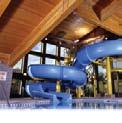
















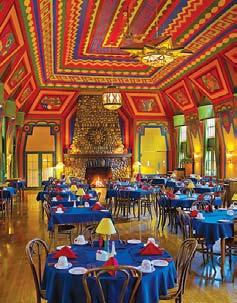









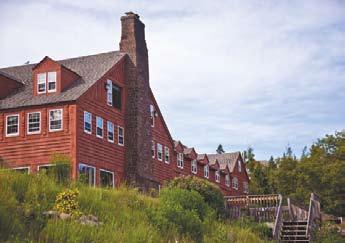
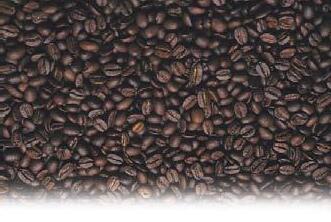

HARBORS’ ORIGINAL IRISH PUB!
By Deane Morrison
Earth sure picked a great month to pass Jupiter.

H arbors ’ largest variety of Bottled Beers, Tap Beers, Irish Whiskeys, and Top -Shelf Spirits! 602 1st Avenue / Two Harbors, MN / 218.834.2300 www twoharborspub com thepubth@gmail.com facebook








December’s dark nights set off the giant planet as we sweep by it on the 2nd, lapping it in the orbital race. Jupiter will then be opposite the sun, rising at sunset and shining all night.

Now in Taurus, Jupiter sojourns close to bright Aldebaran—the eye of the bull—and the V-shaped Hyades star cluster. And on the evenings of Dec. 25 and Jan. 21, the yellow-hued planet becomes an ornament for a waxing moon.
In the first half of December, look in the predawn hour to see four planets at once: in the west, Jupiter, and in the east, Saturn, Venus and Mercury stacked top to bottom. Above and west of Saturn is Spica, the jewel of Virgo.
On the 3rd, Venus appears halfway between Saturn and Mercury. Between the 9th and 11th, a waning crescent moon sweeps by Spica, then Saturn and finally Venus.
See Venus now, because our bright “morning star” is dropping and will soon disappear behind the sun.
The winter solstice arrives at 5:12 a.m. on Dec. 21. “Solstice” means “sun standing still.” We can see this in the times of the year’s earliest sunsets and latest sunrises, which get stalled.
In Ely the sun sets at 4:15 p.m. from Dec. 5 to 16 and rises at 7:57 a.m. from Dec. 28 to
Jan. 4. Due to irregularities in Earth’s orbit, these events don’t coincide with the day of the solstice.
Snow sparkles under full moons the nights of Dec. 27-28 and Jan. 26-27; both moons rise close to the knot of bright winter constellations. Throughout December and January, these constellations—Taurus, Auriga, Orion, Gemini, Canis Minor and Canis Major—rise earlier every night.
Earth reaches perihelion— its closest approach to the sun—at 10:38 p.m. on New Year’s Day. We’ll swoop to just 91.4 million miles from our parent star.
The University of Minnesota offers public viewings at its Duluth campus. Duluth, Marshall W. Alworth Planetarium: www.d.umn. edu/planet

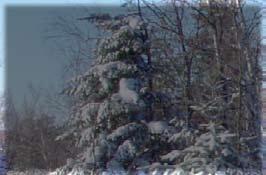
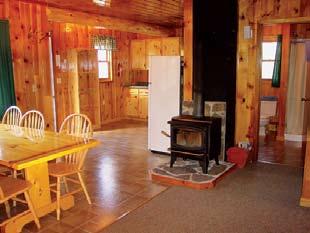
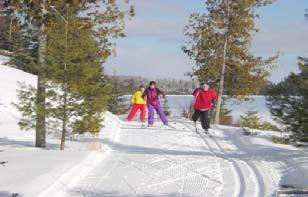
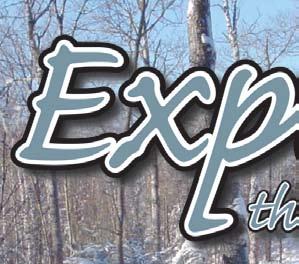

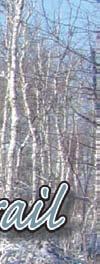
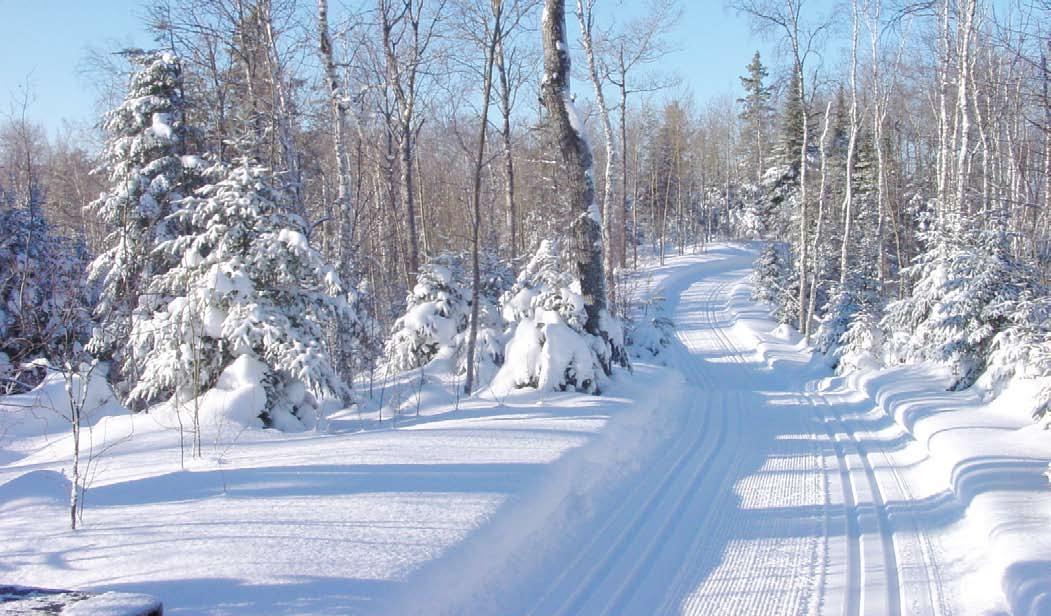


Welcome to Golden Eagle Lodge, a family oriented, year-round resort located on the historic Gunflint Trail of Northeastern Minnesota. We are on the north shore of Flour Lake surrounded by the Superior National Forest. We are the only residents on the lake, so you can look forward to the quiet and solitude offered only from a true wilderness setting.


trail system is tracked for traditional skiing, and much of it is tracked for skate skiing.
We offer complete skiing and snowshoe rentals for all ages, a ski waxing room, a trail lit 7 days a week, a sauna, and an emphasis on silent-sports only (no snowmobiles). All our modern, housekeeping cabins have a fireplace.



Golden Eagle Lodge Nordic Ski Center is worldclass, nationally-known, and silent-sports-only. It is located on the Central Gunflint Ski Trail System. A well-marked network of more than 70 km of groomed trails begin right from your cabin’s doorsteps. Our
We know much time, effort, and expense is invested in a vacation.We would be honored if you considered us as your vacation destination. We go out of our way to ensure every aspect of your visit will convince you to come back and see us again. You won’t be disappointed!